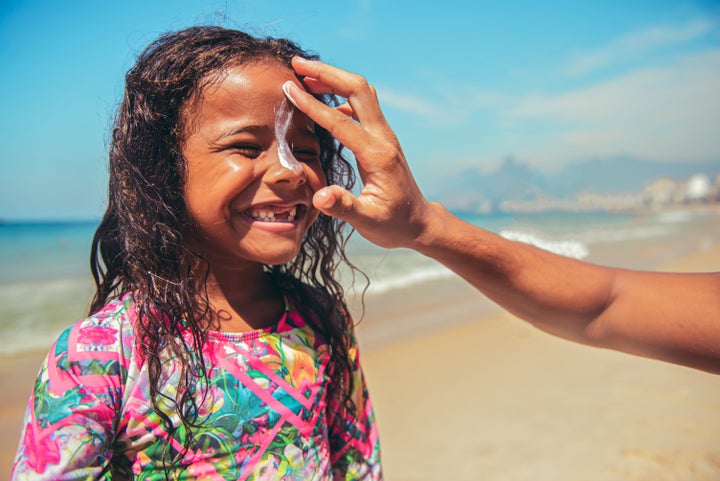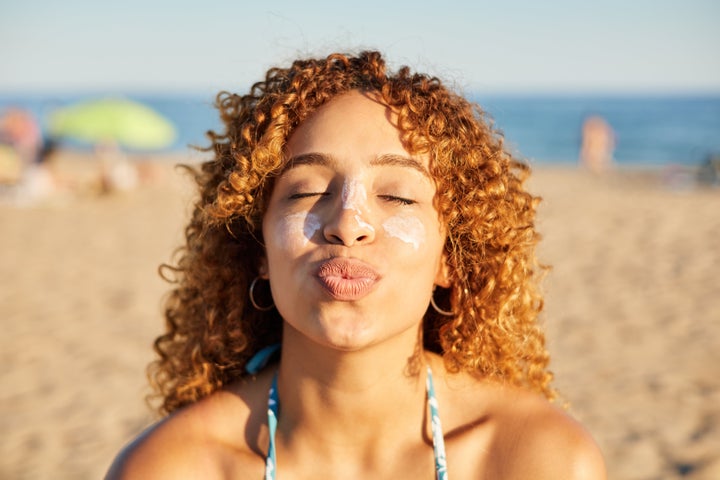
Choosing a sunscreen can be a surprisingly daunting task in the year 2023. Between Instagram ads and influencers extolling the virtues of a sprawling list of brands and the seemingly endless array of options at the drugstore, this daily-use product can evoke some serious decision paralysis.
And then there’s the sheer range of prices. While some bottles of sunscreen retail for less than $10, others go for more than $100.
But is there really much difference between the cheap and expensive sunscreen offerings on the market? Below, dermatologists (and one cosmetic chemist) break it down — and offer their advice for getting the most bang for your buck.
The non-active ingredients may vary
“Expensive sunscreens may offer a more elegant product than cheaper sunscreens,” said Dr Brendan Camp, a dermatologist.
“They may feel lighter on the skin, absorb more easily, or contain ingredients that offer additional benefits, such as peptides, hyaluronic acid or antioxidants. It is important to note, however, that expensive and cheap sunscreens should provide the same degree of sun protection.”
Indeed, the active ingredients in different sunscreens are very similar regardless of how much or how little the product might cost. These are the important sun-blocking components of the formulation, rather than the non-active ingredients that can affect the look and feel of the product.
“There are only a certain number of FDA-approved active ingredients in sunscreens, so there are bound to be similarities across products,” Camp said. “Variations may occur in the vehicle, such as being oil-free or including ingredients that offer additional skin health benefits.”
The blend of these other ingredients can account for the price difference, so you may prefer a more expensive brand for its aesthetic effect or extra bells and whistles.
“There are ‘smart sunscreens’ which contain hydrating moisturising ingredients along with antioxidants to help fight free radical oxidation from environmental exposures like hydrocarbons, pollution and UV radiation,” said dermatologist Dr. Brian Hibler of Schweiger Dermatology Group.
“What is also important to consider are all of the extra additives — fragrance, preservatives, etc. — which can lead to skin sensitivity and are unnecessary in sunscreen formulations,” Hibler said.
“Sometimes, developing a formulation that is devoid of these extra additives can be more costly and lead to a more expensive product.”
Branding and marketing play a role
“Marketing and branding are also other factors that can drive up the price of sunscreen, which means expensive doesn’t always mean better,” said Dr Melanie Palm, a dermatologist at Art of Skin MD in Solana Beach, California.
As with any consumer product, many people are drawn to aesthetically pleasing labels and bottle designs. They may choose a particular product simply because they’ve noticed it all over social media due to strong influencer marketing campaigns.
High-end brands like La Mer can also charge more for their sunscreen because of their association with luxury. And there’s something to be said for the extensive development process and technology these types of companies use.
“Price is affected by product research and development, marketing, the brand and country the product is manufactured in,” said dermatologist Dr Nkem Ugonabo.
“Some companies may be able to invest more money into the formulation and development of the sunscreen, including some of the necessary steps such as undergoing consumer testing and making it more cosmetically elegant.”
Still, it’s important to look beyond aesthetics and brand perception when choosing the right sunscreen for you.
“I think it is helpful to raise awareness of different brands, because there are many great products and formulations out there, but often it takes trying a few to find that one that works best for your individual skin type and routine,” Hibler said.
“Sometimes it is the local drugstore brand. For others, they might enjoy a more expensive formulation.”

Consideration for diverse skin tones can also be a factor
“Some sunscreens are chemical sunscreens, meaning that it protects your skin by absorbing the sun rays,” said dermatologist Dr DiAnne Davis.
“Active ingredients in chemical sunscreens can include, but are not limited to, oxybenzone or avobenzene. Alternatively, physical sunscreens protect your skin by deflecting the sun rays. The active ingredients in physical sunscreens include zinc oxide and/or titanium dioxide.”
If you’ve ever used zinc, however, you probably remember how difficult it was to rub in the product and make it look absorbed.
“In the world of clean beauty, physical sunscreen is often more desired,” said cosmetic chemist Ginger King. “However, it also may leave a white cast on darker skin tone, known as ‘ghosting.’”
Many brands are experimenting with tinted sunscreens and more sophisticated blends to combat this issue.
“Some more expensive sunscreens might have micronised formulations of titanium dioxide, allowing for a physical sunscreen to go on clear and work for all skin tones,” Hibler said. “These sunscreens may go on sheer without leaving behind a white cast.”
Davis believes innovations in tinted sunscreen with iron oxide play a part in branding and marketing as well.
“Does the brand have a wide range of tints/colours/pigments to match various skin tones from the fairest to the darkest?” she said. “That can definitely make a difference in how many consumers the brand is able to reach and influence in terms of purchasing the product.”
But sun protection shouldn’t vary by price
“Because the FDA regulates sunscreens in order to ensure they meet specific safety and efficacy standards, there should be no differences in duration of effect or efficacy among cheap and expensive sunscreens,” Camp said.
Applied properly, SPF 30 sunscreen from a drugstore should be just as good at protecting your skin from the sun as expensive SPF 30 sunscreen from a luxury brand.
“Pricier sunscreens aren’t necessarily more effective than their cheaper counterparts,” Palm said. “In fact, there are plenty of budget-friendly sunscreens that are more effective than pricier options.”
So are more expensive sunscreens worth it?
“It is not necessary to purchase a more expensive sunscreen unless you have a particular preference for how a product feels or agrees with your skin,” Camp said.
“The American Academy of Dermatology (AAD) recommends looking for sunscreens that offer SPF 30 minimum protection, broad-spectrum coverage, and are water resistant. The best sunscreen is one that you enjoy using and meets the recommended AAD criteria.”
Not every formulation will work well with your skin. If you have acne-prone skin, for instance, you may find that certain ingredients clog your pores and cause breakouts. Consult with your dermatologist as you try new sunscreens.
Buying a more expensive sunscreen can also be counterproductive if the price tag makes you feel like you should ration it, and so you don’t apply enough of it or wear it on a daily basis.
“I have tested over 100 sunscreens and can personally say that I liked some more than others despite being cheaper, so price does not always correlate,” Ugonabo said. “I advise my patients to buy whichever sunscreen they like the best, that they can afford.”
“The best sunscreen is the one that you actually like enough to wear every day,” she said. “Whether that is a cheap or expensive one does not matter to me, so long as it meets the criteria for an effective sunscreen.”
That said, some people prefer a pricier sunscreen because of factors they deem superior, like texture and added ingredients. If you’re more likely to use a pricier product consistently because you love how it feels on your skin, then the splurge is worth it.
“I favour Isdin Eryfotona Actinica, a sunscreen with an $80 price tag,” Palm said. “But it’s an effective zinc-based formulation with a plant-based DNA repair enzyme that has been shown clinically to help with pre-cancerous spots and reverse photo damage.
“While expensive doesn’t necessarily mean more effective, the upside of some pricier sunscreen options can include added benefits, like a less tacky finish or a more cosmetically pleasing formulation and beneficial skin care ingredients that simultaneously restore, moisturise, and brighten.”
Another dermatologist, Dr Sheila Farhang, recommended Revision Intellishade, which retails for $84.
“I personally use this SPF that is a 5-in-1, so it hydrates, mattifies, conceals, balances skin PH and brightens,” she said. “It’s hella expensive for many people, but it works for me. And if it is something I’m applying to my face every day, I need to love it.”
Whatever you choose, make sure it meets certain standards
“There are many types of sunscreens,” said dermatologist Dr Shari Sperling. “The most important thing to look for is the SPF number. The higher the better, but you want at least an SPF of 30.”
Remember the SPF in your makeup doesn’t count.
“You want to look for a sunscreen that is broad-spectrum, to protect the skin from both UVA and UVB rays, which both can cause skin cancer,” Davis said. “And also look for a sunscreen that is ‘water resistant,’ which stays effective for 40 minutes in the water, or ‘very water resistant,’ which stays effective for 80 minutes in the water.”
If you’re trying to determine the best sunscreen for your skin type and preferences, consider buying travel- or sample-sized products to test them out before committing to a large bottle, especially if it’s on the pricier side. You don’t want to be stuck with something that irritates your skin or doesn’t go on nicely.
“I also recommend looking for formulations that are noncomedogenic, which are less likely to clog your pores and cause breakouts,” Palm said.
Hibler is a fan of mineral sunscreens with enhanced ingredients that improve the appearance of skin.
“I also look for a sunscreen that is infused with hydrating moisturising ingredients and has added antioxidants to help protect against environmental exposures and reduce photoaging,” he explained. “It is helpful when you can find a sunscreen that is all-in-one to reduce the steps in the morning routine while still maximising your sun protection and giving you radiant skin.”
An ideal sunscreen can be easily applied and reapplied without messing up your makeup, King noted.
“Watch out for the expiration date before you buy,” she said. “All sunscreens have an expiration date printed on the package.”
And don’t forget to use it properly!
Once you’ve purchased your sunscreen of choice, make sure to follow the guidelines for usage.
“When outdoors, it is recommended to reapply sunscreen every 1.5 to two hours after swimming or sweating,” Davis said.
The recommended amount for a full application is about 1/3 of a teaspoon for your face and a shot glass’ worth for your body.
“Remember to complement sunscreen with other sun-protective behaviours, such as wearing a wide-brimmed hat, sunglasses, seeking shade, and avoiding the sun during peak hours,” Camp advised.